Mastitis
Luo: Tuo thuno / Embu: yele / Borana & Gabbra:hiha goru, butha / Kamba: Uwau wa nondo, mukamo / Kipsigis: miatapkinai / Maragoli:lifuuti / Somali: candho-barar, canda-barar, carar, galleh, goof / Turkana: loebeta / Kikuyu: Murimu wa nyondo, kuruara mukamo / Maasai: Enkeeya Ollki / Kiswahili: matiti
mammitis, mammite (French), inflammation de la ubres (Spanish)
Management disease
Introduction
Most mastitis cases result in relatively mild or undetectable inflammation of the udder; called subclinical mastitis. This form of mastitis can persist for the whole life of the cow. The milk gland tissue first hardens and is then slowly destroyed, which can take several lactations until the udder or quarter stops to produce milk at all. The persistent infection in the udder affects the quantity and the quality of the secreted milk. Subclinical mastitis can reduce the milk yield by 40% ! It also spoils the milk quality resulting in rejection of the milk by milk collectors and milk consumers. - All dairy herds have cows with Sub-clinical Mastitis. The percentage of cows infected with subclinical mastitis can be as high as 755.
Seldom occurring but more severe cases of mastitis lead to painful swelling of the affected quarter, abnormal milk, total loss of milk yield or even more severe illness and even death; this form is called clinical mastitis.
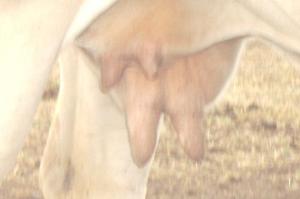 |
| A cow with two lost teats from mastitis |
|
© W. Ayako, KARI Naivasha
|
Causes of mastitis
The most important reservoir of mastitis bacteria is the infected udder. Transmission occurs at milking via the milkers' hands or via the milking equipment.
- Via the hands of the person milking
- Through milking bucket and cloth
- Via flies
- Via the liners of the milking cup (if milking machine is used)
- Via the mouth of the suckling young (esp. kids)
- Through environmental contamination of the stable or the boma (wet and dirty beddings)
- Through contaminated water
- Via contaminated teat dips
- Via intra-mammary infusions
- Teat skin lesions and wounds
- Heifers can become infected with mastitis prior to calving, especially if there a lot of flies.
- Early lactation, when animals give a lot of milk
- High milk yield
- Abnormal teats, the shape of the teat play an important part, as do the presence of wounds on the skin of the teat, especially if they are near the opening
- Lack of hygiene in the milking parlor and during milking
- Adult cattle are most at risk than young ones and can be infected when lactating or during dry period
Sheep and goats can also get a very severe form of mastitis called Contagious Agalactia, caused by another type of mycoplasma, which has similar devastating effect on the goat herd (mastitis, arthritis, abortion, septicemia) as the other mycoplasma in cattle.
Signs of Mastitis
Sub-clinical Mastitis ( "invisible mastitis" because it has almost no visible signs)
- This form of mastitis can persist for the entire lactation and even for the entire life of the cow. Persistent infection of the udder can reduce the milk yield by up to 40%!
- Sometimes small changes in the milk can be detected, small particles are visible in the milk using a strip cup.
- Detection is possible by laboratory examination of the milk to identify the pathogen and also identify the best drug for treatment. Because this mastitis persist for a long time information from the lab can be very useful for the treatment.
- The most efficient way to detect sub-clinical Mastitis is by testing the milk using the California Mastitis Test (CMT), which can be done on the farm. After mixing equal volumes of milk and CMT fluid in the paddle the milk from infected quarters will show higher viscosity (be thicker) than the milk from normal quarters. Testing must be done before milking.
Mild Clinical Mastitis
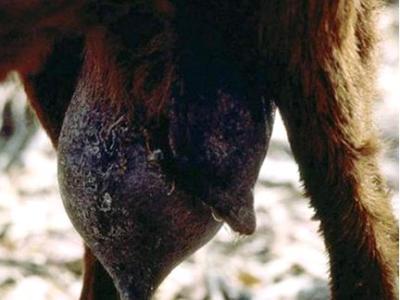 |
| Agalactic mastitis |
|
© John B. Bashiruddin
|
The affected quarter(s) may be slightly swollen and a bit painful (cow rejecting the milking!)
- The udder should be palpated following milking to detect abnormal changes, look at the udder both before and after milking
- Changes in the milk are visible using the black plate in the strip-cup; the milk can be watery, have abnormal color (pinkish or yellowish or containing blood), there may also be flakes or clots in the milk
- This form of mastitis can be life-threatening in dairy cows and also in dairy goats
- Swelling and pain in the affected quarter are very strong; the udder is hot, swollen and painful
- The milk is extremely abnormal: milk becomes thin, watery, yellowish or grey, sometimes with blood clots, milk flow may stop completely
- The cow (goat) stops to feed and is very sick
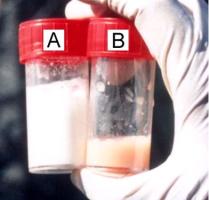 |
| Milk samples comparison for agalactic mastitis |
|
© John B. Bashiruddin
|
Prevention - Treatment
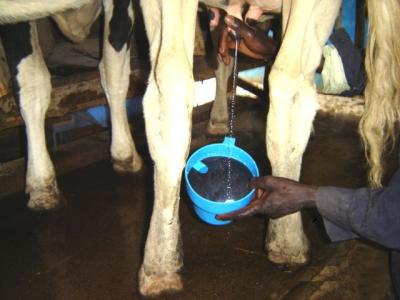 |
| A farmer checking for mastitis |
|
© William Ayako, Kari Naivasha
|
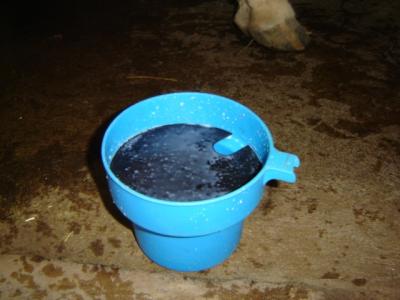 |
| Strip cup for testing mastitis |
|
© William Ayako, Kari Naivasha
|
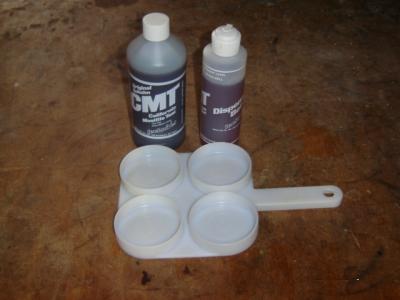 |
| California mastitis tester |
|
© William Ayako, Kari Naivasha
|
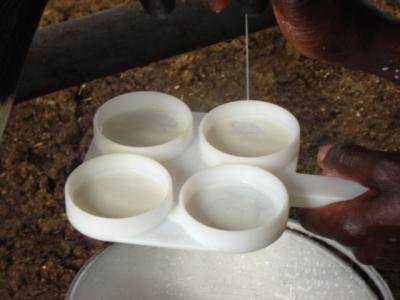 |
| Drawing milk from different teats on a CMT to test for mastitis |
|
© William Ayako, Kari Naivasha
|
The importance of strict milking hygiene
- Milk in a clean environment (no flies!); areas around dairy shed must be dry and free of mud and standing water
- Where machine milking is practiced a footbath with disinfectant should always be provided; teat cup linings can cause damage to the teats and must be changed frequently; vacuum of the milking machine must be checked and the machine must be serviced regularly
- Milk room hygiene including washing of containers and equipment must be continuous
- Use very clean milking equipment
- Wash and dry the teat before milking; it is simple and safe to dry the teats using tissue paper (toilet roll) for cleaning the teats before milking; udder clothes must be disinfected or boiled and allowed to dry in between milking times - otherwise the cloth becomes a source of infection
- Wash hands with soap before milking; clean water mixed with a disinfectant should always be available in the dairy (disinfecting dirt does not work, you have to remove the dirt by washing with soap first, then disinfectthe skin)
- Wash teats before milking
- Use milking salve to protect the teat skin; hand milking must be gentle and never rough; treat all wounds of the teat or of the udder skin with iodine or healing oil as long as the wound is still fresh
- Use the strip cup before each and every milking; first milk squeezed out from each quarter and used to test for mastitis should not be dropped on the floor but should be collected in a separate container with a dairy disinfectant
- Test your cows with CMT regularly
- Use iodine teat dip (contains 1% iodophor or 4% hypochlorite) after milking and change teat dip regularly (the teat dip acts as a barrier and prevents bacteria from entering the teat canal); teat cup must be cleaned and disinfected in between milking times
- Milk cows with mastitis last; always milk CMT-negative udders and young cows first, because their udder are less likely to be infected; this prevents spread of mastitis from one cow to another
- For high yielding cows during early lactation milking three times a day is recommended
- Old cows with chronic mastitis and abnormal teats and cows with persistent mastitis should not be treated but culled
Step 2: Clean and dry the end of the teat
Step 3: Apply disinfectant to the tip of the teat
Step 4: Put the nozzle of the tube into the teat and squeeze the content up into the teat
Step 5: Massage the teat upward
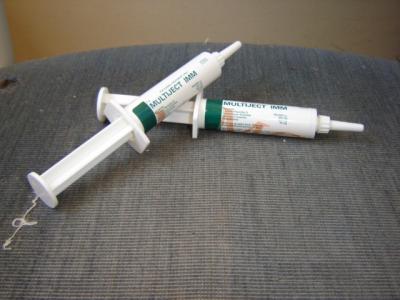 |
| Multi ject tubes for treatment of mastitis |
|
© William Ayako, Kari Naivasha
|
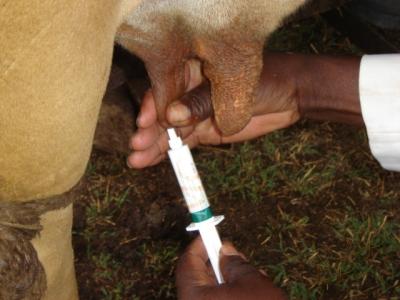 |
| A cow with mastitis undergoing treatment |
|
© William Ayako, Kari Naivasha
|
The most damaging and persistent pathogen causing subclinical mastitis is Streptococcus agalactiae. It is also the only mastitis pathogen that can be eradicated from a herd. If a laboratory has identified this pathogen in your milk you should consult a veterinarian to make a control plan.
Acute or Severe Clinical Mastitis
